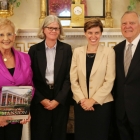Members of Congress are currently working toward passing a bill that would lower interest rates for students borrowing money for school after rates doubled July 1, 2013.
The piece of legislation voted on in the Senate Wednesday, July 24, will tie students’ interest rates to the market, which means that rates will fluctuate annually. The bipartisan bill, which is expected to lower interest rates to 3.86 percent for both subsidized and unsubsidized undergraduate loans, is expected to be voted on by the House of Representatives sometime this week.
“The legislation that had kept the rates at 3.4 percent expired on June 30,” said Sarah Baumhoff, KSU’s associate director of Financial Aid. “At that point in time, the rates for both subsidized and unsubsidized loans went to 6.8 percent so that is where they stand currently.”
Baumhoff said the compromise in Congress will set interest rates annually according to the U.S. Treasury 10-year borrowing rate. Once a loan is signed, those interest rates will be fixed for the life of that loan.
“It will be 5.41 percent for graduate students on unsubsidized loans and the parent PLUS loan rate would go to 6.41 percent,” Baumhoff continued. “It would be retroactive back to every loan that was certified as of July 1 so everybody would get the new interest rate—even if they’ve signed something already.”
According to financial aid data provided by Baumhoff, KSU had 15,686 students with federal loans during the 2012- 13 year. Of those students, 79 percent received a subsidized loan.
Dean of Student Success Michael Sanseviro said he remains optimistic that an agreement will be reached to minimize the impact on students.
“Most KSU students receive financial aid of some kind, and many do rely on loans that will be impacted by any change,” Sanseviro said. “It is difficult to predict the level of short-term impact, but there is no doubt that there will be long-term ramifications. “ Sanseviro said the students most directly impacted by the increased rates will be those who accept unsubsidized loans because their interest begins accruing immediately.
“I suspect if the interest rate is higher than desired, many students will avoid taking loans or minimize the amount of money they borrow and instead choose to work as much as possible,” he said. “The more hours students work, the less time they have to study and invest in important leadership and service activities.”
The proposed legislation would also set caps on the interest rates to protect students and their parents. The bill will ensure that rates do not exceed 8.25 percent for undergraduate students, 9.5 percent for graduate students and 10.5 percent for students and parents who accept PLUS loans.
Baumhoff said people often asked her why the interest rates were set the way they were because they seemed like arbitrary numbers.
“This is now tying it to something that parents and students can see because it’s the U.S. Treasury rate,” she said. “But that means the rates can change—that means they can go up and down– but they’re putting caps on it, and I think that it makes sense that it flows with the market.”
Sanseviro said he supports keeping interest rates as low as reasonably possible, but he is equally sensitive to why rates fluctuate.
“It took a really long time to pay off my student loans, but I have absolutely no regrets,” he said. “Without those student loans, I would never have been able to complete my education, and my education has been the best investment of my life.”


